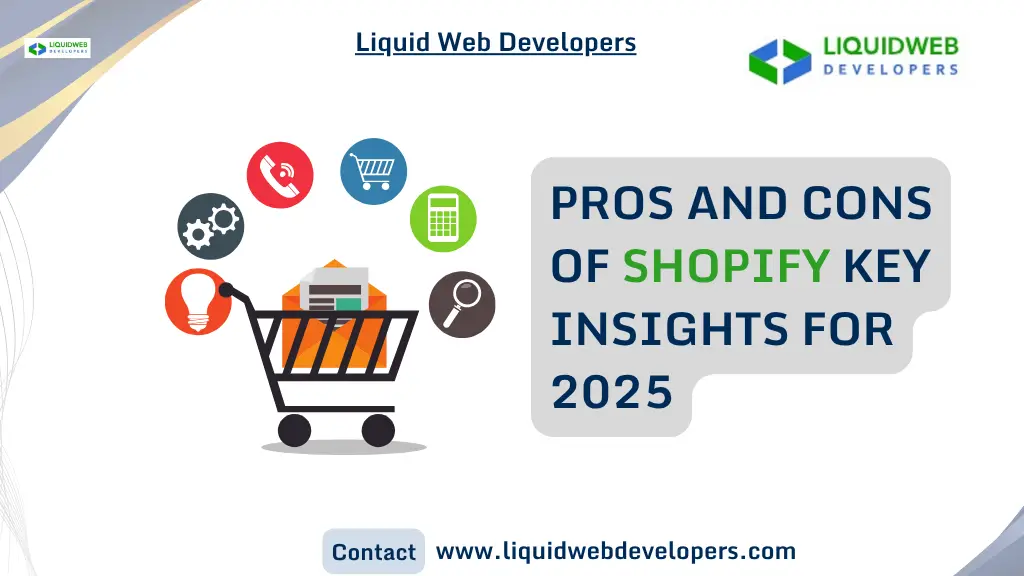Pros and Cons of Shopify: Key Insights for 2025

Is Shopify the Right Platform for Your Business?
Shopify is an established name in the world of e-commerce; however, in 2025, the marketplace has grown, and with it, the expectations of users. If you’re planning to launch your first product or transferring from a different system to Shopify, evaluating Shopify requires more than superficial capabilities. This guide reveals the strengths and weaknesses of the platform in a manner that is reflective of what is important in the current online commerce.
Ease of Use and Setup
Pros:
- Shopify offers a minimal learning curve, which makes it accessible to users who’ve never run an online store before. You can go from sign-up to a functioning storefront in hours, not days.
- Its interface simplifies decisions. You’re not overwhelmed with technical jargon or configuration options at step one.
- Initial setup flows more like a guided checklist than a development project.
Cons:
- The ease comes at the cost of control. Advanced store behaviors often need paid apps or workarounds.
- Once you grow beyond standard needs, the “simplicity” starts to feel like a limitation rather than a benefit.
- Relying on default settings may leave your store under-optimized without you realizing it.
Pricing Structure and Transaction Fees
Pros:
- Predictable, flat-rate plans reduce billing surprises, which is useful when budgeting for growth.
- No additional infrastructure or hosting fees—it’s all part of the package.
- Businesses with steady monthly revenue can scale their plan with minimal disruption.
Cons:
- Shopify takes a cut if you don’t use its in-house payment system. This fee structure can punish businesses using external payment processors.
- To unlock some essential features, you may need to move up to a higher plan—even if you don’t need everything that plan includes.
- Small costs (apps, themes, add-ons) compound quickly, especially for lean startups.
Theme Customization and Design Flexibility
Pros:
- Themes on Shopify are built for visual storytelling—layouts are clean, performance-optimized, and conversion-aware.
- You don’t need to write code to achieve a polished, professional look. Most storefront edits are made visually.
- Developers can go deeper with customizations using Liquid, CSS, and section-based theme architecture.
Cons:
- Free themes offer limited layout diversity. If you want something truly unique, you’ll need to purchase or build your own.
- Editing global design elements isn’t always intuitive for non-technical users.
- Many stores using Shopify tend to look similar unless extra effort is made to differentiate the design.
App Ecosystem and Third-Party Integrations
Pros:
- The Shopify App Store acts like a toolbox—you can pick exactly what you need, when you need it, without bloating your core site.
- New integrations are constantly released, keeping the platform current with digital marketing and fulfillment trends.
- You’re rarely locked out of functionality. If Shopify doesn’t offer something natively, an app probably does.
Cons:
- App dependency is a real concern. Over-reliance can lead to performance drag and maintenance headaches.
- Many apps require separate subscriptions, which are billed monthly. This adds unpredictability to your cost model.
- App quality varies. Not all developers offer consistent support or documentation.
Payment Processing and Gateway Options
Pros:
- Shopify Payments is deeply embedded into the checkout experience, offering frictionless processing for most regions.
- You can accept a wide range of payment methods out of the box—including mobile wallets, buy-now-pay-later options, and region-specific systems.
- Integration with major gateways is handled cleanly, with minimal manual setup required.
Cons:
- The best fee structure is locked behind Shopify Payments, leaving international merchants at a disadvantage.
- You don’t get total freedom over your payment flow—checkout customization has limitations.
- Not all payment gateways support advanced features like multi-currency or recurring billing by default.
Inventory Management and Product Organization
Pros:
- Inventory is managed in real time, which reduces overselling risks and helps forecast stock.
- Shopify supports multiple product options and variants natively, helping sellers organize complex catalogs.
- The admin panel makes batch edits quick, even for stores with hundreds of SKUs.
Cons:
- Features like partial stock alerts or automatic restock scheduling require third-party tools.
- Managing products with multiple layers (e.g., kits, bundles, or B2B pricing) is cumbersome without add-ons.
- Native reporting doesn’t provide deep insights into stock velocity or dead inventory.
SEO and Marketing Tools
Pros:
- Shopify’s structure follows clean technical SEO principles—fast load times, mobile responsiveness, and schema basics are baked in.
- Blogging, metadata editing, and product tagging are supported without plugins.
- Discount codes, abandoned cart recovery, and email capture integrations help support acquisition and retention.
Cons:
- You can’t fully customize URLs—segments like /collections/ are fixed, which may impact long-term SEO structure.
- Some marketing tools feel overly simplified and may not serve high-volume businesses well.
- Advanced SEO needs—like internal link strategy or structured data layers—require apps or manual coding.
Shopify Feature Pros & Cons Comparison
| Feature | Pros | Cons |
| Ease of Use | Intuitive setup, minimal learning curve | Limited flexibility for advanced workflows |
| Pricing | Scalable, clear billing | App and transaction fees add up |
| Theme Customization | Clean designs, editable without coding | Deeper customization needs developer effort |
| App Ecosystem | Expansive tools for any need | Can cause performance issues and rising costs |
| Payment Gateways | Multiple options, integrated experience | Shopify Payments offers better terms than external processors |
| Inventory Management | Real-time tracking, bulk tools | Not robust enough for complex or B2B inventory needs |
| SEO & Marketing Tools | Built-in basics and marketing automation | Advanced SEO functions not natively supported |
Making Your Shopify Decision
The Shopify you see in 2025 is a refined version of its former self—still intuitive, but now serving a wider range of businesses, from solo creators to major online brands.
Consider Shopify if:
- You want to launch quickly without sacrificing aesthetics or functionality.
- Your business model aligns with a SaaS structure—flexibility within predefined limits.
- You value access to an ecosystem that grows with your store.
Consider alternatives if:
- You need full control over data structures, server access, or custom checkout flows.
- You’re building a highly complex marketplace, subscription service, or wholesale portal.
- You prefer ownership of your tech stack and hosting environment.
Conclusion
Shopify is a reliable platform until 2025, specifically for business owners who want speedy execution as well as stability and accessibility to a global eCommerce infrastructure. But, it’s not an all-inclusive solution. The more complex your business needs get, the more precisely you’ll have to evaluate the benefits and drawbacks. Its most important asset is its it’s simplicity. The biggest flaw? The same simplicity could turn into a challenge when your requirements become more complex.
